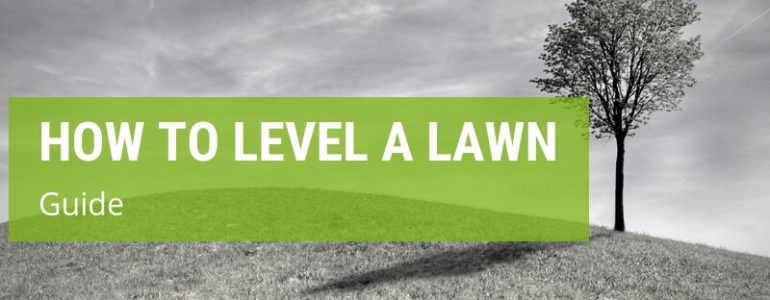Every homeowner wants the lawn in their property smooth and even. But due to many reasons, some areas would become uneven and bumpy over time. In most cases, you can solve this problem on your own with some simple methods, depending on the level of severity. If you have never experienced this issue, then keep reading to find out some useful tips and techniques on how to level a lawn.
Why is it important to level your lawn?
A flat, smooth lawn without depressions or bumps is important because it will offer a much safer and more usable surface for you to walk on or perform any activities, for adults and children alike.
Also, everybody homeowner should know that a flat grass surface makes it simpler to maintain and ensure a healthy lawn. This does not only allow for better quality cuts as the mower won’t scalp the top layer, but you would also mow faster without jumping around.
It’s really difficult to see how you could create beautiful patterns on your bumpy lawn.
Good drainage is another benefit of keeping your lawn level. With a smooth surface, you can prevent rain or irrigation water from accumulating in low spots and holes, which could increase the risks of lawn diseases.
What causes a bumpy lawn?
Before doing anything to resolve the problem, it is necessary to understand why your lawn gets bumpy and even overtime.
Drainage issues
The most common causes of uneven lawns are erosions caused by drainage issues, broken water pipes, or a faulty sprinkler system. If you notice 2 to 3 low spots where the water pipes are installed, make sure to investigate as soon as possible.
Ground settling
Ground subsidence or settling is the process of lowering the ground surface due to many natural causes like thawing and freezing cycles, rain, earthquakes, or the nature of the ground. It occurs over time and results in depressions in your lawns.
Thin lawn
Having a thin lawn due to insects or diseases can also weaken the ground and lead to patches of bare soil. Those areas tend to erode deeper with activities, wind, and rainfall, thus causing depressions.
Activities
Another source of bumps can come from the activities of people and animals who walk on the lawns. Both domestic and wild animals tend to dig holes on the ground, which gathers water and causes erosion. The same can be true when you play and walk on the surface for a long time.
Three techniques to level a lawn
There are many ways to level a lawn with bumps and depressions. The right solution for you will depend on the severity of the area such as extreme cratering or minor depressions. Here are three common techniques to try:
1. A lightly bumpy lawn
For mildly uneven areas, topdressing is probably the simplest and least invasive method. Here’s what you need to do:
Step 1:
Mix a batch of compost, sand, and topsoil in a container or wheelbarrow.
Step 2:
Apply 0.5 inch of the soil mixture on these low areas on your lawn. Since this method should be gradual, you don’t need to remove the grass. Also, avoid making deeper.
Step 3:
Use a rake to spread out the mixture
Step 4:
Use a push broom to work the mixture between the grass’s blades thoroughly
Step 5:
Track the progress in the lawn until there is only grass on the surface, no dirt. If the lawn is still bumpy, repeat these steps until you get the desired results.
What this short clip to learn more about how to topdress your lawn:
2. A moderately bumpy lawn
The topdressing technique mentioned above often takes a few days or weeks to work. Also, it won’t be really effective when you have a few more low spots in the lawn. In these cases, the best solution is to pick up the sod and put dirt under this layer. Here’s how it works:
Step 1:
Remove the grass layer in those low spots. If the areas are large, consider cutting out and set aside separate chunks to make it easier to carry around without breaking.
Step 2:
Use the shovel to fill the hole with topsoil so that the area would be smooth after you change the sod.
Step 3:
Add water while shovelling the soil to get rid of air pockets, which might ruin your work.
Step 4:
The last step is to change the sod, then water the grass.
3. A heavily bumpy lawn
Finally, we’ll show you how to deal with the most extreme case of uneven lawns. Is the surface so littered and full of craters which make it looks like top part of the moon? When the bumpy spaces are numerous and considerable that makes it impossible to solve the issue with both methods above, then you might need to carry out a more extensive renovation by rearranging the surface and creating a new layer of grass. Basically, there are two simple options to choose from:
- Grow the grass from seeds
- Lay the sod
Both options are quite simple to do on your own in a couple of hours. After you have established the surface, it is important to maintain the grass regularly and properly to extend the lifespan.
Preventative measures
Once you have levelled your lawn and created a smooth surface, it is important to take some preventive measures to maintain it and avoid adding new bums. Basically, there are two things that you should do:
- Avoid stepping or walking on the lawn when it is very wet.
- Change the cutting pattern of the lawn mower (check some here) wheels between cuts to avoid generating ruts.







